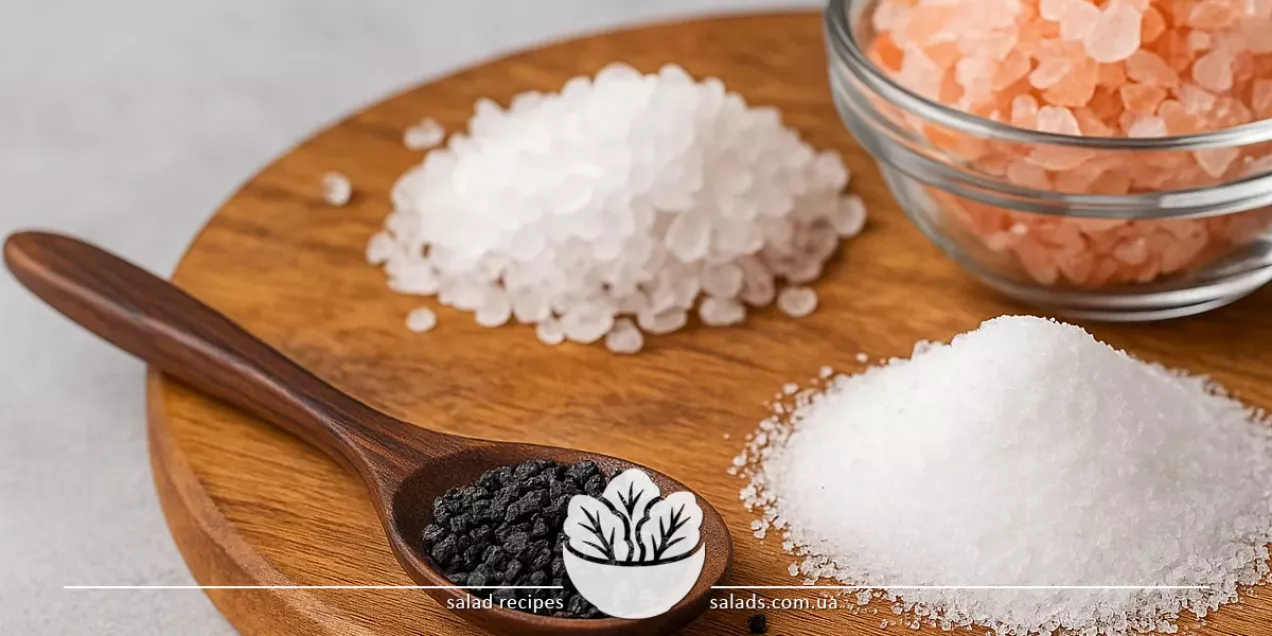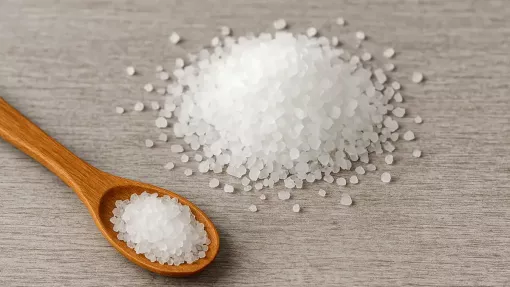Salt

Salt is one of the oldest and most important seasonings in culinary history, serving both a flavoring and technological function. Adding salt improves dough structure, stabilizes egg proteins, helps preserve the natural color of vegetables during boiling, and enhances the aroma of spices in complex blends. Modern cuisine uses many types of salt – from classic table salt to exotic varieties like Himalayan pink or volcanic black salt. Salt is also a component of marinades, sauces, seasonings, and even desserts. You can learn more about other spices in the spices category.
Different Types of Salt
Main Varieties of Edible Salt
Salt varies not only by origin but also by structure, color, level of refinement, and culinary properties. The most common is table or rock salt – finely or medium ground, white in color, mined underground and subjected to multiple purification stages. This type of salt is convenient for everyday use in soups, sides, meat, and vegetable dishes. It is often iodized to support thyroid function. Sea salt forms naturally through the evaporation of seawater. It may have a crystalline structure, a more pronounced mineral taste, and retain trace elements like magnesium, calcium, and potassium. This salt is generally milder in taste and valued in recipes that emphasize natural ingredient flavors. Pink Himalayan salt contains traces of iron oxides, giving it a distinctive color. It is used not only in cooking but also for presentation or adding textural contrast. There are also exotic types: black salt from India with a sulfurous aroma, smoked salt dried over wood smoke, and flake salt used as a finishing touch. Some chefs use flavored salt mixed with herbs or dried vegetables. Particularly popular are salt blends with spices, such as pepper, garlic, or smoked paprika – combinations that significantly enrich a dish without requiring separate ingredients.
Technological Role of Salt in Cooking
Salt plays not only a flavor-enhancing role in cooking but also an important technological one. When boiling vegetables, it helps preserve their color and texture; in meat dishes – it improves juiciness and promotes crust formation; in broths – it activates the release of flavor compounds. In baking, salt balances sweetness, stabilizes gluten in the dough, and increases elasticity. It also slows yeast activity, which is why it’s added later in the kneading process. In protein-based foods like eggs, salt helps stabilize foams during whipping. In meat, it affects protein denaturation, making the texture denser – particularly noticeable when salting or marinating. Salt also lowers the freezing point of liquids, which is important in certain cooling and preservation methods. In vegetable and grain dishes, salt is often added near the end of cooking – allowing better control over the salt level. The amount of salt in recipes should always be balanced – too much can overpower the dish, while too little can make it bland. In complex recipes like marinades or sauces, it’s advisable to account for the salt content in other ingredients – broths, soy sauce, or vegetable bases. For instance, sugar is often added to balance saltiness and create flavor depth in combination with acids or spicy seasonings.
Salt in Different Cuisines Around the World
Despite being universal, salt plays a unique role in every world cuisine. In Mediterranean tradition, coarse sea salt is widely used – added gradually to dishes and often used to garnish grilled foods and vegetables. In Asian recipes, salt is often combined with soy sauce, miso, and fermented seasonings – reducing the amount needed without sacrificing flavor. In Indian cuisine, black salt (kala namak) with its sulfuric aroma is commonly used in chutneys, snacks, and vegetarian dishes. In Latin American cuisine, salt is frequently paired with lime, chili, and herbs to prepare marinades, salsa sauces, and spice blends for meat and fish. In Northern Europe, salt is often combined with sugar – for example, in gravlax preparation, where fish is cured in a mix of salt, sugar, and spices for fermentation and preservation. Smoked salts are also popular in Scandinavian countries, lending dishes a deep aroma.
In Ukrainian cuisine, salt is used in all core dishes – borscht, porridges, stewed vegetables, meat, and fish. It’s also a basic component for preservation – salting cucumbers, cabbage, tomatoes, and mushrooms. It is frequently included in traditional sauces such as garlic or horseradish sauce. In modern recipes, salt is often combined with aromatic additions: dried herbs, pepper, paprika, citrus zest. It’s important to consider ingredients that intensify saltiness or spiciness. For example, types of soy sauce are naturally salty and can partly replace salt in dishes that require deeper flavor balance.
Flavored Salt and Spice Mixes
Salt is often used as a base for seasoning blends, combined with spices, dried vegetables, herbs, and aromatic ingredients. These flavored salts allow you to quickly enrich a dish without measuring each spice individually. Popular variants include salt with dried garlic, lemon zest, chili, basil, oregano, and smoked paprika. They are suitable for meat, fish, grilled vegetables, fried potatoes, soups, and even certain sauces. Some blends are inspired by national cuisines: “Italian salt” with tomatoes, basil, and rosemary; “French salt” with Provençal herbs; “Indian” with turmeric, ginger, and cumin. Flavored salt is especially valued in home cooking for its convenience – a single seasoning makes the dish tasty and well-balanced. It also saves time when preparing marinades or braising bases.
Special attention should be given to combinations of salt with spicy or aromatic ingredients. For example, salt with dried chili or allspice provides a piquant accent in familiar recipes. These blends are great for finishing dishes – sprinkling over food after cooking, where it’s important to preserve the texture and aroma of the spices. In desserts, sweet recipes with caramel, chocolate, or nuts are often enriched with salt to deepen flavor. One example of such bold pairings is garlic – one of the most common companions to salt in seasoning blends for grilling, roasting, or sauces. Garlic salt is versatile and used in soups, salads, meat dishes, and even steamed vegetables.
How to Choose Quality Salt and Store It at Home
Though salt may seem like a simple ingredient, its quality significantly affects the final outcome of a dish. When choosing, check the composition: high-quality salt should not contain unnecessary additives, such as anti-caking agents or artificial flavors, especially if you plan to use it in pure form. For daily use, fine or medium-ground salt is ideal – it dissolves quickly and distributes evenly in food. Coarse crystals are better suited for curing, baking, or as a finishing salt. Packaging also matters: the container should close tightly and protect from moisture and light. The best storage spot is a dry, cool cupboard, away from heat and steam. If you use multiple salt types – for example, sea, Himalayan, or flavored – it’s best to store them separately in labeled jars. For flavored salt or herb mixes, airtight containers are recommended to prevent aroma loss. A basic home set might include regular iodized salt for everyday cooking, sea salt for finishing or salads, and one or two blends for meat or roasting. If unsure about the salt quantity in a recipe, it’s better to start with less and adjust after cooking. Ingredients with natural saltiness – such as onion – also impact flavor balance and should be considered during preparation.
